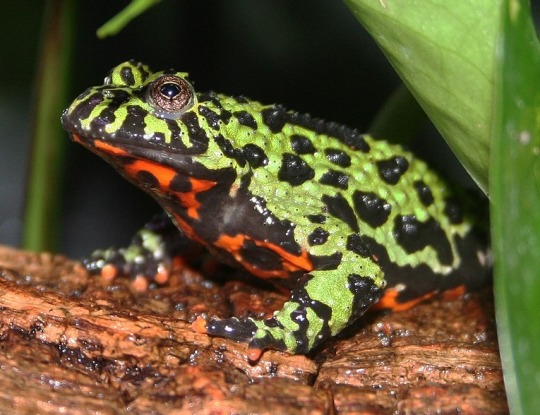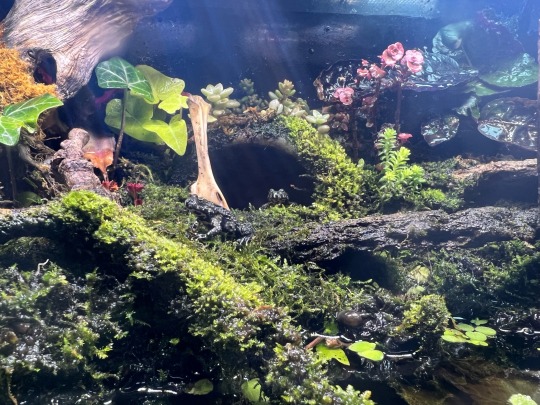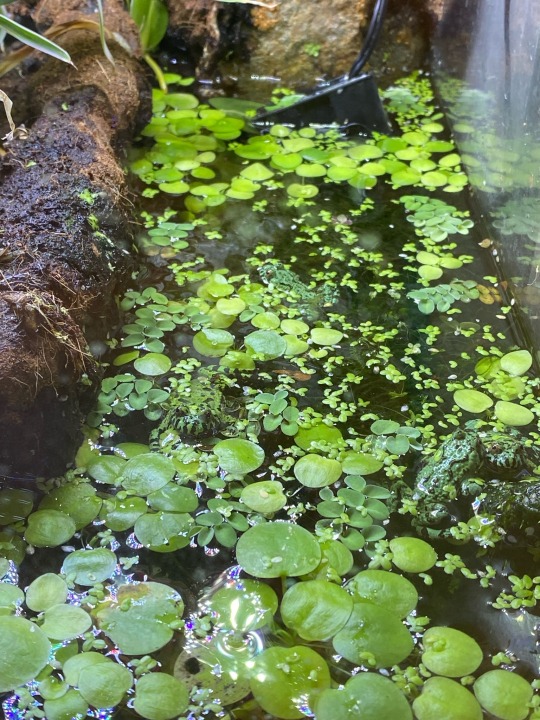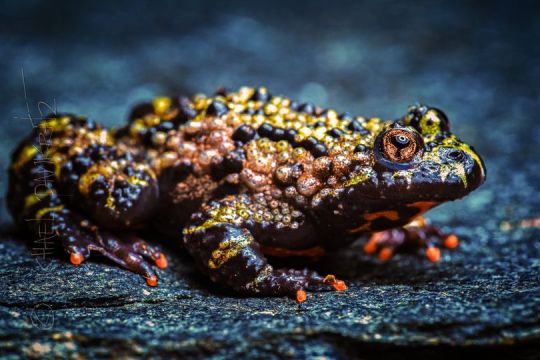#fire-bellied toads
Explore tagged Tumblr posts
Text
Closed rp
Shina was, in a word, freaking out.
Jiraiya had asked her out on a date to a fancy restaurant. She had NO IDEA how to dress for a fancy restaurant or how to behave in one. She desperately dug through her closet in a towel, having finished cleaning herself up not too long ago, trying to find something that even remotely looked fancy in her clothing. She found a backless red dress and a pair of long red gloves with a pair of stilettos, and, since she had nothing else, she pulled those on and somehow managed to pull a look together. She heard a knock at the door and pulled the door open.
@thetoaddaddy
#Multimuse rp#Shina enters the ring!#Shirayia#Fire-Bellied Toads#closed rp#She be like fuck it we roll with this!
38 notes
·
View notes
Text
Among the most popular pet frogs, and among the most charming, are the fire-bellied frogs or toads - in the strictest sense, they aren't either - such as Bombina variegata, the yellow-bellied toad of the Western Palaearctic realm, and specifically Central and Southern Europe. This is a small and easily housed frog species, growing to a snout-to-vent length of 2.8 to 5.6 centimeters, or about 1 to 2 inches.
Within this species, racial differences exist in their markings across their geographical range. The northeastern populations are genetically distinct from their conspecifics in the rest of its distribution, to their west and their south. This deep divergence implies a pre-glacial common descent, and long isolation owed to climatic factors. For this species, the Carpathian Mountains were an ecological refuge, from uninhabitable Pleistocene climates. Also an Italian race of yellow-bellied toads, is often nowadays elevated to full species tank, as B. pachypus.
Bombina is a member of the costate frogs, a clade that also includes the well known genera Discoglossus and Alytes, the painted frogs and midwife toads. Costate frogs competently walk and hop, but they are not long-range jumpers. The costates are not only early diverging, but also protomorphic, retaining unspecialised pelvises that reflect their locomotor conservatism. It is the rearrangement of the pelvis in certain, unrelated frog clades, that allows such derived frogs to jump perfectly.
Bombina sp. are collectively known as the fire-bellied toads, because of their easily visible, yellow to red underbellies. As in those newts with a similar ventral coloration, this has evolved as an aposematic warning, or an advertisement of their toxicity to deter potential predators. To make obvious their coloration, these amphibians display their bellies when they are threatened by a larger carnivore, by flipping onto their own backs, or by employing the body language of raising up - this is the famous 'unken reflex'.
The species of Bombina are distributed from Europe across to Siberia and down beyond China. They are truly a Palaearctic faunal component, but their distribution is non-continuous, which is a result of ancient climate changes. There is an early divergence within the genus Bombina, separating a southern subclade, known as the B. maxima complex, and also a secondary division within the more northerly group, into the European group and the eastern B. orientalis.
At lower elevations, B. variegata lives in deciduous forests, whereas in higher terrain it is a denizen of conifer forests. A habitat generalist, B. variegata utilities diverse lentic and lotic waters. Relative to a sometimes sympatric Bombina species, B. bombina, it eats more terrestrial arthropods than aquatic prey in the wild. This fact allows for some niche partitioning where both species of Bombina are present in the wild.
Although the two species of fire bellied frog are quite distinctive in their looks and vocaluzations, they hybridize readily. However both morphospecies remain distinct, owing to natural selection disfavoring the fertile hybrids that result from these pairings. Thus in the case of these two Bombina species, racial mixing does not result in de-speciation through hybritity, nor has it resulted in the evolution of a new species from the hybrid stock.
B. variegata inhabits temperate, seasonal climates and the daily temperature it experiences, can shift by up to 10 degrees in the course of a day. A study of a B. variegata locality, found that the water temperature was 4 to 24 degrees centigrade, depending on the season. Whilst the air temperature there was 3-31 degrees. (At other localities where B. variegata is present, the water temperature may itself be 31 degrees.) Their season of activity begins at 8-10 degrees centigrade
B. variegata and other Bombina species need to have only shallow water provided for them, because they do not make deep dives for their food. Ideally, these anurans should be able to stand on their toes, reaching up so their faces are above the water. These anurans receive UV wavelengths as daylight in the wild, and benefit from a UVB emitting light source in the aquaterrarium. Bombina sp. do not damage live plants, and are thus suited to a planted aquaterrarium.
Some people have successfully cohabited Bombina sp. with other animals species, but there are risks. These frogs can reflexively lunge at animals that are perceived prey, and their glandular skins are themselves toxic, possibly creating problems should other animals come into contact with their skins. Nonetheless, similarly sized climbing animals, like tree frogs and anoles have been cohabited with Bombina sp. because they inhabit different areas of the enclosure, which minimizes interactions. Regarding conspecifics, male Bombina sp. may be aggressive to one another. The males of these frogs, have longer forearms than to the females.
However, on the down side, Bombina sp can (sometimes) be difficult to feed on a proper captive diet. Often, Bombina adapt to taking items such as floating sticks. Therefore it is untrue that their intended food needs to move, without which the feeding response cannot be stimulated. However, this does not mean that all individuals in these species, are equally willing to do so.
Non-living items in the water are more likely to elicit a feeding response, because chemosensory cues travel better through water than through air, however, contrary to popular factoids, it has also been argued for decades that frogs can see non-moving items, and recognize them as food. I am aware that frogs belonging to distantly related taxa, can and do eat pre-killed prey - these are costates, pipids, bufonids, hyloids, and ranoids.
It is widely reported, and I can see no reason to doubt it, that the species of Bombina differ in their temperature tolerances and optimums. All species of Bombina should be fine at cool room temperatures year round, in a cool temperate climate. That is to say, when and where it is suitable for humans to live comfortably, without feeling hot.
Despite being quite southern in its origin, the popular giant fire belly species, B. maxima from high altitudes in southern China, is said to require lower ambient temperatures, than do the European species. But I know for a fact that B. maxima can be acclimatized, like members of the more northern clade, to an ambient temperature of 24 or 25 degrees centigrade. And I am positive that these frogs encounter such temperatures, which are scarcely soaring, in their wild, subtropical latitude habitats.
Although the B. maxima species complex, which extends to Taiwan and northern Southeast Asia, include the largest of the fire bellied frogs, but even they are not huge. It is rare for individuals to exceed 6 and a 1/2 centimeters, or 2 and a 1/2 inches long. There is still systematic disagreement between herpetologists, as to which populations within this clade constitute separate species, or for that matter, the extent of the different species recognised within this phylogenetic nexus.
The archetypal fire-bellied frog, the European B. bombina, is less commonly encountered in exotic retail, than is the Oriental or Korean fire-belly, B. orientalis. This is a very similar animal to the western B. bombina, the European fire-belly, but the East Asian species has a distribution from the Amur region down to northern China. This is a popular species for those interested in studying animal behavior. It grows to 4 or 5 centimeters, or 1 and a 1/2 to 2 inches.
#Bombina variegata#yellow-bellied toad#fire-bellied toads#fire-bellied frogs#aquaterrarium pets#Bombina maxima#Bombina orientalis
1 note
·
View note
Text

Oriental fire-bellied toad (Bombina orientalis) By: Charles E. Mohr From: Living Amphibians of the World 1966
117 notes
·
View notes
Text

Oriental Fire-bellied Toad (Bombina orientalis), family Bombinatoridae, found in far eastern Asia
Poisonous.
photograph by Laurent Lebois
425 notes
·
View notes
Text

Reptiles, Amphibia, Fishes and Lower Chordata. Written by Richard Lydekker and others. Illustration by J. Green. Published in 1912.
Internet Archive
155 notes
·
View notes
Note
Your frog Mikey design looks like he’s a poisonous frog. He’s prolly not but theres something dangerous about his bright orange color…
Ps. Actually obsessed with how you draw this au tho
they are poisonous, but not dangerous to humans

(THANK YOUUU 💖💖💖)
#talking cockroach#tmnebt ask#“When threatened by a predator the fire-bellied toad will lift up its arms to expose its red coloration and show off its toxicity”#<- from wiki#I NEED TO DRAW THIS KXSKKCEOLD
83 notes
·
View notes
Note
Hello! I’m new to the Pizza Tower fandom but I have drawn the silly goopy goober and would love to show you! Hope you don’t find this weird lol

yESSS YEEEEEESSSS THAT IS A WONDERFUL COLORFUL BOY 👏👏👏👏👏
the more Fakey designs this fandom has the better, please continue to make wonderful colorful frogs for me 🤗🤗
(he looks like a poison dart frog too hehe, very vibrant friend)

(like THIS ⬆ handsome specimen!)
#i will hug him even if it is dangerous. might be dangerous. he is pretty bright and Poison looking.#but WORTH IT ✨#pizza tower#pizza tower fake peppino#god. now i want a pet frog again.#i used to have a fire bellied toad when i was younger but he passed away very tragically 😔#maybe someday once i get a stable income hehe
37 notes
·
View notes
Text

Decorated my new plant's pot with a bombina orientalis (oriental fire-bellied toad)!!! 🐸
#my art#art#artists on tumblr#artwork#frogs#frog#frogs and toads#toads#bombina#fire bellied toads#paint pens#plants#plantblr
20 notes
·
View notes
Text
My son is seven years old and loves the sound of setting the timer on the stove
12 notes
·
View notes
Text

him cozy under leaf
8 notes
·
View notes
Text

Just hangin out
10 notes
·
View notes
Text

Some fire-bellied toads I met briefly
#animal#animals#pet#pets#herptile#herptiles#cute animal#cute animals#cute pet#cute pets#fire belly toad#toad#frog#toads#frogs#fire bellied toad#fire belly toads#fire bellied toads#frogcore#froggy#froggo#pet frog#pet frogs#duckweed#aquarium#vivarium#terrarium#paludarium#paludariums#aquariums
26 notes
·
View notes
Text

European fire-bellied toad (Bombina bombina) By: Gerhard Budich From: Living Amphibians of the World 1966
51 notes
·
View notes
Text

Oriental Fire-bellied Toad (Bombina orientalis), family Bombinatoridae, found in far eastern Asia
Poisonous.
photograph by Michael Pankratz
182 notes
·
View notes
Text
What ist your favourite animal fact?
Mine is that fire-bellied toads help dig each other into the ground for winter :D
#it's cute when you know that they stay there safe and happily#but it sounds like they are digging each others graves#toads#animals#animal#frog#fire-bellied toad#animal facts#frog facts#toad facts#pls answer I want to know more
16 notes
·
View notes
Text



First two are poison frogs third I believe is a fire bellied toad but I'm unsure! I had completely forgotten to look at his little information thing, They're all super cool though!
Sunday, April 21st 2024 3:42-3:44pm
4 notes
·
View notes